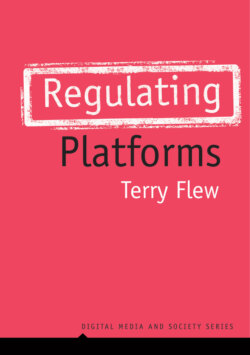Читать книгу Regulating Platforms - Terry Flew - Страница 24
Digital Platforms as Media Companies?
ОглавлениеAn important element of the argument against the regulation of digital platforms has been that they are not media companies. The Facebook CEO Mark Zuckerberg has consistently argued that the social media platform is a technology company and not a media company, as it is a distributor of content that is produced and shared by others rather than a publisher or a producer of original content (Zuckerberg and the Senate Commerce, Science, and Transportation Committee, 2018). The distinction is legally important, since the safe harbour provisions in Section 230 of the Communications Decency Act 1996 and related legislation arise from a distinction between platforms and publishers that provides platforms with broad legal immunity – that is, absolves them from any responsibility for the content hosted on their sites (Gillespie, 2018a, pp. 30–40). It also reflects a conceptual distinction between twentieth-century mass media and twenty-first-century convergent social media (or Web 2.0). The former are characterized by large-scale distribution, media content of broad appeal, high barriers to entry for new content distributors, the dominance of media professionals, and a largely one-way communication flow; the latter are characterized by dramatically reduced barriers to entry, increasingly ‘niche’ media content markets, the rise of pro-am media content producers, and greater empowerment of user audiences through interactivity and two-way communications flows (Flew, 2014b; Hartley, 2012).
Both the legal and the conceptual foundations of the claim that digital platforms companies are primarily technology companies and not media companies have been challenged. A whole range of public inquiries, hearings, and reports on digital platforms and the social media have consistently argued that these companies should bear a social and moral responsibility, and possibly a legal responsibility too, for the content posted by users that is hosted on their sites. To take one example, in the United Kingdom, a report on fake news by a House of Commons committee concluded as follows:
Social media companies cannot hide behind the claim of being merely a ‘platform’ and maintain that they have no responsibility themselves in regulating the content of their sites. We … [recommend] that a new category of tech company is formulated, which tightens tech companies’ liabilities, and which is not necessarily either a ‘platform’ or a ‘publisher’. This approach would see the tech companies assume legal liability for content identified as harmful after it has been posted by users. (House of Commons Digital, Culture, Media and Sport Committee, 2019, p. 10)
Philip Napoli and Robyn Caplan have offered a detailed critique of the argument that digital platform companies are simply technology companies and not media companies (Napoli and Caplan, 2017). They observe that the definition of a media company typically associates its activities with the distribution and exhibition of media content and not simply with its production, and from this perspective companies such as Google, Facebook, Apple, Twitter, and others are clearly moving towards the centre of the media ecosystem. In the area of news, for example, about 40 to 45% of news consumers identify online sources, including social media, as their primary news source (Newman et al., 2019). The lines between production, distribution, and exhibition are also increasingly blurred, as Amazon Prime, Apple TV+, and others are subscription video-on-demand (SVOD) services that commission original content – and YouTube Originals and Facebook Watch commission original content too. YouTube has evolved over time from a largely amateur-driven ‘broadcast yourself’ platform to one where multichannel networks engage content creators whose relationship to the platform is akin to that of small-to-medium enterprises (SMEs) that work with a large-scale content distributor (Burgess and Green, 2018; Cunningham and Craig, 2019). Moreover, as noted above, digital platform companies routinely engage in human intervention around the promotion, downgrading, and deletion of online content on their websites – an activity analogous to the editorial function of traditional media. Finally, digital platforms compete directly with traditional media companies for advertising revenues. This puts them in ‘the business of providing content to audiences, while selling those audiences to advertisers’ – which ‘is a defining characteristic of the media sector’ (Napoli and Caplan, 2017).
In McQuail’s Media and Mass Communication Theory, McQuail and Deuze (2020) offer a series of counterpropositions to the claim that we have witnessed a transition from mass communication towards more digitally enabled interpersonal communication. They argue that digital platforms have introduced a higher degree of audience segmentation, which was enabled by predictive data analytics and behavioural assumptions based on revealed online activity, but that they do so through aggregation at scale. Digital platforms do not approach audiences as a mass, but they aggregate increasingly fine-grained individual preferences into a mass form that can – as with traditional mass media – be onsold to advertisers. What we have, then, is not the superseding of mass communication by interpersonal communication, but new ways of mixing the two forms, which are increasingly combined with human–machine communication and – as the internet of things evolves – with machine–machine communication.
The political economy of digital capitalism has thus seen the rise of global platform giants whose activities span telecommunications, information, and media and on which traditional media industries are increasingly dependent for their survival. The key to the hegemonic dominance of the platform companies is their unique access to so-called big data from multiple sources, where communication activities at scale are important generators of such data. Put differently, while online users may not experience digital platforms as mass media, they themselves are approached as masses, both by the platforms and by the third parties that use these platforms for commercial or for persuasion-related purposes (e.g. in political communication); and this remains the case even if online users are approached as segmented mass audiences – segmented, that is, along behavioural and psychographic as well as demographic categories.2
